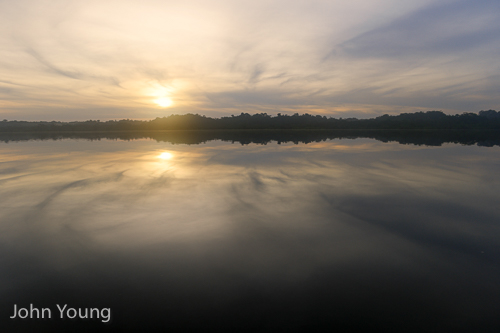Last Tuesday, I headed into the Amazon Basin. First, I took a 40 min. flight from Quito to Lago Agrio, a town that was quite recently built up due to the oil industry. I was met by the guide, Stalyn, and my six fellow travellers, two friends from Nanaimo, two others from Belgium, and two from Poland. We took the tour bus to the bridge over the Cuyabeno River, and after lunch we loaded up our motorised canoe and headed downriver, admiring the sights as we went.
 |
| Stalyn pointed out these sleeping bats |
 |
| Anhinga--looks like a heron, but is a swimming bird. |
 |
As these birds flew overhead, Stalyn called out, "Blue and yellow macaws." I remarked that I didn't know
how he knew they were blue and yellow, because up in the sky they just looked black to me. |
We saw hordes of squirrel monkeys swinging through the trees as they chattered at us.
 |
The Huatzin, commonly know as "Stinky Turkey," due to the food they eat that acts as a deterrent to predators. I thought maybe they were saying, "Here come some stinky gringos again!"
After motoring for three hours, we reached the lodge, and were treated to a wondeful meal. We usually had soup, and then the main dish, of meat, chicken, or fish, and vegetables. And always lots of juice, water, coffee, or tea. Then we went out on the water.
 |
| Along with several other boats from some of the other nearby lodges, we headed out to the Laguna Grande each evening, |
|
 |
to admire the sunset . .
We went out one morning at dawn, 6 a.m.
Neotropic cormorant
Common potoo - well-camouflaged. Our guide was amazing the way he could pick out the critters!
We also went for a night hike, and Stalyn picked out the critters by seeing the red of their eyes.
A large spider
A scorpion
A lobster.
A frog.
A tarantula. Stalyn knew where its lair was, and pried it out with a stick.
We took a tour to a nearyby indigenous village, and saw cassavah being prepared, right from scratch, including the digging
up of the roots from the tree yucca. The yuccas grow back in 5-6 months. A renewable resource!
Stalyn calling the Red-throated Caracara Falcon on one of our day outings. The falcon called threateningly from way up in the canopy, too far away for a photo, but visible through binnoculars.
The poison dart frog, traditionally used by the Indigenous people for hunting.

A Walking Palm Tree - from the time it's a seedling until adult, it can move up to 1 meter.
A flock of parakeets perched in the tree near our lodge.
Nests of the raucous Oropendula at our lodge -- noisy from first light until dusk, when the insects took over.
Black-skinned parrot snake.
Leaf-cutter ants carrying leaves back to their home. Always busy!
Not many big trees in the jungle, but this Sable was one of them.
And, yesterday, the boat-ride back up the river, going a lot faster than we went going down., and the magic was over . . . .
|
































Love the photos John! Such varied plant and animal life! Thank you for sharing.
ReplyDeleteThanks. It was a pleasure sharing.
DeleteAwesome John. What an adventure. Looking forward to a slide show when you get back.
ReplyDeleteThanks Dwight. It will be difficult to pare the images down to one slide-show!
DeleteSuper images. Looks like you had a great tour.
ReplyDeleteThanks Patrick. Yes, Ecuador is wonderful!
Delete